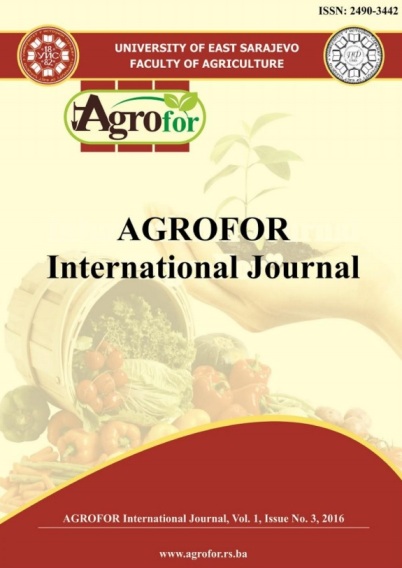PERFORMANCE OF SOYBEAN (Glycine max L.) INFLUENCED BY DIFFERENT RATES AND SOURCES OF PHOSPHORUS FERTILIZER IN SOUTH-WEST NIGERIA
DOI:
https://doi.org/10.7251/AGRENG1603046OAbstract
Low yields of soybean in Nigeria are attributed to many factors such as declining
soil fertility and use of low yielding soybean varieties. Phosphorus is a soybean
plant growth-limiting nutrient.Therefore, application of phosphorus fertilizer at
optimum level is essential. Two experiments were carried out at Ibadan, Nigeria to
estimate the optimum P-fertilizer rate for soybean and to investigate the response
of soybean to different sources of P fertilizer applied at the optimum rate. The
treatments in the first experiment were two soybean varieties (TGX1987-10F and
TGX1987-62F) and single superphosphate (SSP) fertilizer applied at five rates:
0kgPha-1, 20kgPha-1, 40kgPha-1, 60kgPha-1 and 80kgPha-1. The treatments in the
second experiment were: SSP, Tithonia compost (TC), poultry manure (PM),
TC+PM, SSP+TC, SSP+PM applied at optimum P (40kgPha-1)rate obtained from
Experiment 1and control. Data collected on morphological parameters, grain yield
(GY) and nutrient uptake were subjected to analysis of variance, the means were
separated using least significant difference (p<0.05). Results showed that
TGX1987-62F (1.96Mgha-1) produced significantly higher GY than TGX1987-10F
(1.26Mgha-1). Application of SSP at 40kgPha-1 produced tallest plants (131.8cm),
highest number of leaves/plant (19.0), number of pods/plant (19.4), and GY
(2.28Mg/ha) across the two varieties. Highest K-uptake (6.1mgplant-1) and Puptake
(2.6mgplant-1) were obtained in plants treated with TC+SSP and SSP,
respectively. The combination of TC and SSP at 40kgPha-1 produced highest
number of flowers/plant (35.6), pods/plant (38.7) and GY (3.9Mgha-1). A
combination of Tithonia compost and SSP applied at 40kgPha-1 will increase grain
yield of soybean in South-West Nigeria.

